Complete Solutions to Questions of chapter FOOTSTEPS TOWARDS (JEE MAIN) of Class 10 book with complete answers and questions
| Class 10 | CHEMISTRY |
| Chapter | FOOTSTEPS TOWARDS (JEE MAIN) |
| MTG IIT JEE FOUNDATION | Questions |
| Number Of Questions | 20 |
| Academic Year | 2023-24 |
The position of elements A and B are shown in the periodic table below.

Which of the following statements is correct about the two elements?02:16View SolutionFor the given series of reactions,
`{:(NaCl+X+Y+NH_(3)to NaHCO_(3)+NH_(4)Cl),(" "Delta darr-"X,"-Y),(" "Q overset(+10H_(2)O)larrZ):}`
Following statements are given :
(i) This reaction is a Solvay's process.
(ii) X and Y are `CO_(2)` and `H_(2)O` respectively.
(iii) Z is `(NH_(4))_(2)CO_(3)`.
Identify the correct option.02:20View SolutionP is produced by the action of chlorine on dry slaked lime.
Q is a non-corrosive base and used for faster cooking. On heating R at 373 K, it becomes calcium sulphate hemihydrate.
Identify P, Q and R respectively.View SolutionA metal rod M was dipped in a coloured solution Y. After some time it was observed that the metal rod starts dissolving in the solution and the solution starts fading in colour. However, a coloured precipitate Z was seen at the bottom of the beaker. M, Y and Z could be
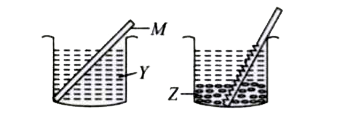 01:57View Solution
01:57View SolutionStudents were asked to study the reaction between barium chloride and sodium sulphate. Four different reports of the experiment are given below. Choose the correct one.
01:15View SolutionIn the Modern Periodic Table, calcium (Z = 20) is surrounded by the elements with atomic numbers 12, 19,21 and 38. Which of the following will have physical and chemical properties resembling calcium?
 01:42View Solution
01:42View SolutionWhat will be the pH value of a solution if salt of a strong base and weak acid undergoes hydrolysis?
View SolutionClean small pieces of magnesium, zinc, aluminium, iron and copper by rubbing them with a piece of sand paper. Take them in separate test tubes. Add about 10 mL of dilute hydrochloric acid to each of them.
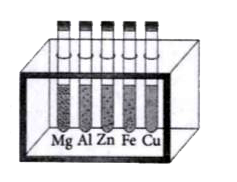
Consider the following statements.
(i) The rate of evolution of hydrogen gas bubbles is not same in all the test tubes.
(ii) The rate of formation of bubbles is the fastest in the case of magnesium.
(iii) The reactivity decreases in the order:
`Mg gt Zn gt Al gt Fe gt Cu`.
(iv) In the case of copper, no bubbles are seen and the temperature also remains unchanged. This shows that copper does not react with dilute HCl.
Identify the correct option.View SolutionObserve the given figure and identify the correct statements.

(i) Magnesium ribbon burns in air with a dazzling white flame.
(ii) It is a displacement reaction.
(iii) Magnesium oxide is basic in nature and turns most red litmus paper blue.
(iv) It is an exothermic reaction.View SolutionEthanoic acid was added to sodium bicarbonate solution and the gas evolved was tested with a burning splinter. The correct observation is
View SolutionFour students performed the reactions of dil. hydrochloric acid and solution of sodium hydroxide with zinc metal and solid sodium carbonate separately. They reported the possible reaction by and no reaction by (x).
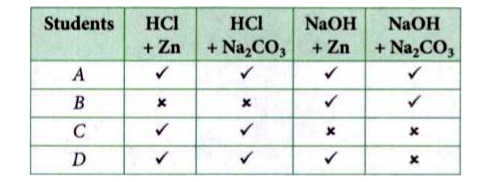
Which student has report the correct observation?02:40View SolutionThe ion of an element has 3 positive charge. Mass number of the atom is 27 and the number of neutron is 14, what is the number of electrons in the ion?
View SolutionIdentify the metal (X) and gas (Y) respectively in the figure.
 01:11View Solution
01:11View SolutionThe structures of three hydrocarbons, X, Y and Z are shown below:
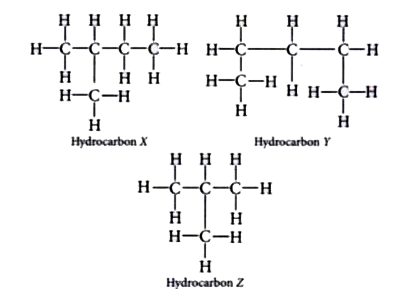
By considering the following statements, identify the correct option.
1. X and Y are isomers.
2. X and Y have the same percentage composition by mass.
3. Y is the isomer of alkane having formula, `C_(5)H_(12)`.
4. Z has the same boiling point as n-butane.02:07View SolutionThe given diagram shows the electron arrangement of two elements, A and B.

By considering the following information, identify the correct option.
(i) A is a period 3 element.
(ii) B is a group III element.
(iii) Both A and B have strong metallic characteristics.
(iv) Both A and B form positive ions.02:22View SolutionReaction between X and Y, forms compound Z. X loses electron and Y gains electron. Which of the following properties is not shown by Z?
View SolutionConsider the following statements.
(i) Dry hydrogen chloride gas turns dry blue litmus paper red.
(ii) Dry hydrochloric acid does not turn moist blue litmus paper red.
(iii) If dry HCl gas is passed through benzene, it will not turn dry blue litmus paper red.
(iv) When HCl gas is passed through water, the solution turns dry blue litmus paper red.
Identify the incorrect option.02:57View SolutionStudy the following steps.
`Cu_(2)S overset("roasted in air")to (X) overset("roasted without airI")to (Y)`
Based on the above steps, identify X and Y.
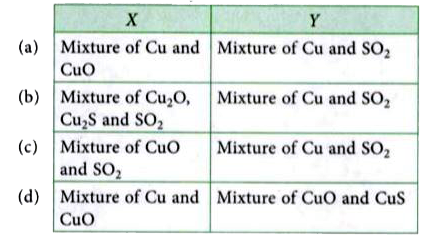 01:42View Solution
01:42View SolutionThere are four metals P, Q, R and S. Identify them by using the hints given below.
P forms basic oxide.
Q forms amphoteric oxide.
Oxide of R dissolves in water to form alkali.
S does not react with water at all.02:05View SolutionWhich of the following flames is produced by a candle?
01:04View Solution
Questions questions and complete solutions for chapter FOOTSTEPS TOWARDS (JEE MAIN) of MTG IIT JEE FOUNDATION of Class 10
